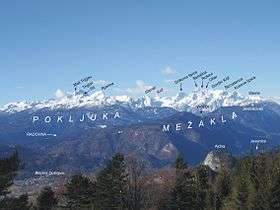Julian Alps
| Julian Alps | |
|---|---|
 The Eastern Julian Alps and Mount Triglav | |
| Highest point | |
| Peak | Triglav |
| Elevation | 2,864 m (9,396 ft) |
| Coordinates | 46°23′N 13°50′E / 46.383°N 13.833°E |
| Geography | |
.png) Julian Alps (in red) within the Alps.
The borders of the range according to Alpine Club classification of the Eastern Alps | |
| Countries | Italy and Slovenia |
| Range coordinates | 46°20′N 13°45′E / 46.333°N 13.750°ECoordinates: 46°20′N 13°45′E / 46.333°N 13.750°E |
| Parent range | Southern Limestone Alps |
The Julian Alps (Slovene: Julijske Alpe, Italian: Alpi Giulie, Venetian: Alpe Jułie) are a mountain range of the Southern Limestone Alps that stretch from northeastern Italy to Slovenia, where they rise to 2,864 m at Mount Triglav, the highest peak in Slovenia and of the former Yugoslavia. They are named after Julius Caesar, who founded the municipium of Cividale del Friuli at the foot of the mountains. A large part of the Julian Alps is included in Triglav National Park. The second highest peak of the range, the 2,775 m high Jôf di Montasio, lies in Italy. [1]
The Julian Alps cover an estimated 4,400 km2 (of which 1,542 km2 lies in Italy). They are located between the Sava Valley and Canale Valley. They are divided into the Eastern and Western Julian Alps.
Eastern Julian Alps

There are many peaks in the Eastern Julian Alps over 2,000 m high, and they are mainly parts of ridges. The most prominent peaks are visible by their height and size. There are high plains on the eastern border like Pokljuka, Mežakla and Jelovica.
The main peaks by height are the following:
- Triglav 2,864 m (9,396 ft) – the highest mountain and on the coat of arms of Slovenia
- Škrlatica 2,740 m (8,990 ft)
- Mangart 2,679 m (8,789 ft)
- Jalovec 2,645 m (8,678 ft)
- Razor 2,601 m (8,533 ft)
- Kanjavec 2,568 m (8,425 ft)
- Prisojnik 2,546 m (8,353 ft)
- Prestreljenik 2,499 m (8,199 ft)
- Špik 2,472 m (8,110 ft)
- Tosc 2,275 m (7,464 ft)
- Krn 2,244 m (7,362 ft)
Western Julian Alps
The Western Julian Alps cover a much smaller area, and are located mainly in Italy. Only the Kanin group lies in part in Slovenia. The main peaks by height are:
- Jôf di Montasio (2,755 m or 9,039 ft)
- Jof Fuart (2,666 m or 8,747 ft)
- High Mount Kanin (2,582 m or 8,471 ft)
Passes

Important passes of the Julian Alps are:
- The Vršič Pass, 1,611 m (5,826 feet), links the Sava and Soča valleys. It is the highest mountain road pass in Slovenia.
- The Predil Pass (links Villach via Tarvisio and Bovec to Gorizia), paved road 1,156 m (3,792 feet)
- The Hrušica Plateau at the Postojna Gate: (links Ljubljana to Gorizia), paved road 883 m (2,897 feet)
- The Pontebba Pass (links Villach via Tarvisio and Pontebba to Udine), railway, paved road, 797 m (2,615 feet)
Gallery
 The Julian Alps
The Julian Alps
 The Julian Alps with Prisojnik and Razor
The Julian Alps with Prisojnik and Razor The Krnica Valley near Kranjska Gora
The Krnica Valley near Kranjska Gora Mount Mangart
Mount Mangart
References
See also
External links
| Wikimedia Commons has media related to Julian Alps. |
